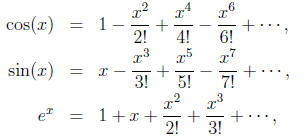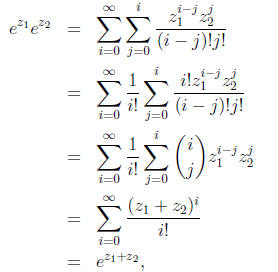Complex Numbers and the Complex Exponential
3 Polar Form
The set of points at unit distance from the origin in the complex plane ,
corresponding to
the complex numbers z with |z| = 1, form a circle of unit radius centered at the
origin. This
circle is called the unit circle in the complex plane. Every point on the unit
circle can be
represented in the form z = cos θ+ j sin θ, where (from now on) θ
represents an angle.
More generally, as illustrated in Fig. 1(b), a complex number z = a + b j can be
represented
in the polar form

where r = |z| and, if z ≠ 0, cos θ = Re(z)/|z| and sin θ = Im(z)/|z|.
The angle θ is called
the argument or phase of z, and is denoted arg(z). The phase of z = 0 is not
defined.
Now, since cos(x) and sin(x) are periodic with period 2π
, it is clear that if  is a value of
is a value of
arg (z), then so are  , and so on. Thus arg(z)
does not specify a
, and so on. Thus arg(z)
does not specify a
unique angle, but rather it specifies an infinite class of equivalent angles,
each differing from
the others by some integer multiple of 2π . For example,

So that every complex number has a unique phase, we can select an angle from any
half-open
interval I of the real numbers of length 2π , so that it is impossible for
more than one angle
from each equivalence class to fall in I. By convention, this interval is
usually chosen as
(-π , π], and the corresponding angle is referred to as the principal value of the
argument,
denoted Arg(z), or ∠z. Note the capital letter: whereas arg(z) denotes an
infinite set of
equivalent angles, Arg(z) specifies a unique angle in the range (-π , π].
Thus, for example,

Although polar form is an inconvenient representation for complex addition, it
is great for
multiplication. Indeed, if we multiply  with
with
 ,
,
we get

We see that under complex multiplication, magnitudes multiply and phases add,
i.e.,

and

where the latter equality is interpreted in the following way: if we substitute
a specific angle
for  and a specific angle for
and a specific angle for
 , their sum is a member of the equivalence
class of
, their sum is a member of the equivalence
class of
angles of  .
.
Now, if z ≠ 0, we have z(1/z) = 1; this means that if z has the polar form
 ,
,
then 1/z must have the polar form

so that their product has the polar form 1 = 1(cos 0 + j sin 0). Thus taking
reciprocals in
polar form is just as convenient as complex multiplication. It follows from this
that if  ≠ 0
≠ 0


and
 , provided
, provided  ≠ 0.
≠ 0.
The property that the phase of a product is the sum of the phases is very
reminiscent of
the rule for multiplying exponentials, where the exponent of a product is the
sum of the
exponents, i.e.,  . As we will see in the next
section, where we consider the
. As we will see in the next
section, where we consider the
complex exponential function, this connection is not a coincidence.
4 The Complex Exponential
To define a complex exponential function ez, we would certainly wish
to mimic some of the
familiar properties of the real exponential function; e.g., ez should
satisfy, for all  and
and
z,

(The last equation requires that we first define what we mean by complex
differentiation,
something that is beyond the scope of these notes. However, see, e.g., [1, 2].)
Here we will
introduce the complex exponential in a sneaky way: via its Maclaurin series.
(Recall that
the Maclaurin series of a function is the Taylor expansion of the function
around zero .)
Recall that the real-valued functions cos(x), sin(x), and ex have
Maclaurin series given,
respectively, by

and that each of these series is convergent for every value of x ∈ R.
It would be natural indeed to define

and this is precisely what we will do. Although we will
not prove this here, the Maclaurin
series (4) is convergent for every value of z ∈ C. Clearly this
complex-valued exponential
agrees with the usual real-valued exponential at every point z on the real-axis
in the complex
plane.
To see that  , we multiply the corresponding
Maclaurin series. This method of
, we multiply the corresponding
Maclaurin series. This method of
multiplying series is sometimes called the Cauchy product. We want to form

Using the distributive law and grouping terms having the
same total exponent (sum of
![]()
exponent and ![]() exponent), we get
exponent), we get

This sum can be written as

where, in the second last equality, we have made use of
the binomial expansion (which holds
in any field).
Now, writing z = a + jb, with a ∈ R and b ∈ R, we find that

Since ea is a (well understood) real-valued
exponential, we see that the key to understanding
the complex-valued exponential is to understand the function ejb for
real b.
For this, we apply the Maclaurin series. We have, for real b,


where we have used the fact that j2 = -1, j3
= -j, j4 = 1, etc. Grouping the real and
imaginary parts, we find that, for real b,

Thus we find that ejb is essentially a
trigonometric function: it has real part cos b and
imaginary part sin b. Applied to z = a + jb, the complex exponential returns

Using the complex exponential allows us to write, in a
more compact way, the polar form
(3) of a complex number having magnitude r and phase θ we have

The fact that phases add under complex multiplication now becomes obvious, since

Since cos(- θ) = cos(θ ) and sin(-θ ) = -sin(θ ), we have

Adding the two equations in (5) yields
 , or
, or

Subtracting the two equations in (5) yields
 , or
, or

These relationships often allow one to derive various
trigonometric identities via the complex
exponential function.
| Prev | Next |